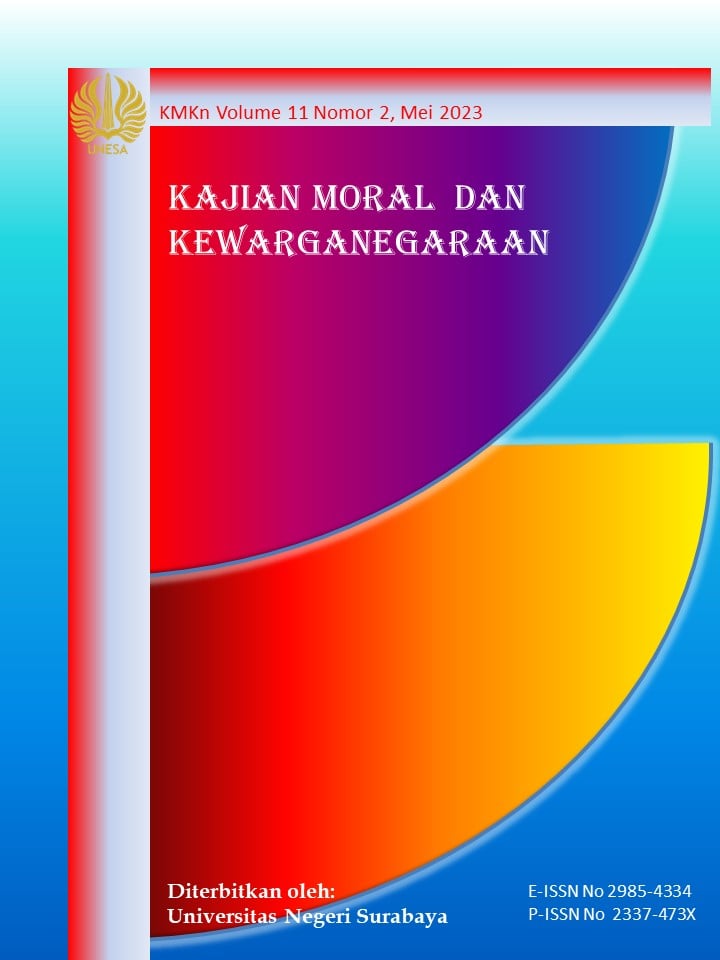RESPON MASYARAKAT JEMUR WONOSARI TENTANG BERDIRINYA SANGGAR CANDI BUSANA PENGHAYAT KEPERCAYAAN SAPTA DARMA DITINJAU DARI SIKAP MULTIKULTURAL
DOI:
https://doi.org/10.26740/kmkn.v11n2.p478-493Keywords:
Penghayat Kepercayaan Sapta Darma, Sanggar Candi BusanaAbstract
This study aims to describe the response of the Jemur Wonosari community regarding the establishment of the Sanggar Candi Busana for followers of the Sapta Darma belief in terms of a multicultural attitude. The theory used in this study is the SOR (Stimulus-Organism-Response) theory discovered by Hovland. This theory assumes that a certain stimulus (verbal words, non-verbal cues, and symbols) will stimulate other people or groups to respond in a certain way as well. In this study using qualitative research methods with descriptive research type. The informants in this study were determined using a purposive sampling technique. The number of informants was selected with the consideration of the people living around the Sanggar Candi Busana building and also community leaders related to the activities of the Sapta Darma belief system until data saturation was obtained. The informants in the study found ten informants consisting of the community, community leaders in the Jemur Wonosari sub-district, and religious leaders of the Sapta Darma belief. The location in this study was in the Jemur Wonosari sub-district, Wonocolo District, Surabaya City. Data collection techniques used were in-depth interviews and observation. The results of this study indicate that the residents of Jemur Wonosari gave two responses, namely, the response before the public knew the function of the Fashion Temple Studio. And the positive response to the existence of the Sanggar Candi Busana and adherents of the Sapta Darma belief, community members live side by side. Acceptance of community members is part of humanist communication, Sapta Darma activities which involve the community as a form of upholding the value of harmony. A multicultural attitude emerges where society maintains harmonious relations and provides space for differences in belief and worship without disturbing or disturbing.
Downloads
References
Azis, F. 2017. Konstruksi Sosial Penghayat Kerokhanian Sapta Darma (KSD) Terhadap Ajaran KSD Dalam Kehidupan Sosial. Skripsi. Universitas Airlangga.
Dwiyanto, D. 2010. Penghayat Kepercayaan Terhadap Tuhan Yang Maha Esa di Daerah Istimewa Yogyakarta. Yogyakarta:Pararaton.
Effendy,O.U. 2003. Ilmu, Teori dan Filsafat Komunikasi. Bandung: PT. Remaja Rosdaka.
Fahrurrozi, M. 2019. Studi Tentang Pelaku Konversi Agama Dari Islam Ke Penghayat Kepercayaan Sapta Darma Di Jemursari Surabaya. Skripsi. Universitas Islam Negeri Sunan Ampel.
Haryanto, J. T. 2018. Negara Melayani Agama dan Kepercayaan Konstruksi Agama dan Pelayanan Negara Terhadap Umat Beragama dan Perkembangannya di Indonesia. LITBANGDIKLAT press.
Khoiludin, T., Royani, M. Y., Anwar, k., dkk. 2019. Jalan Sunyi Pewaris Tradisi: Diskriminasi Layanan Publik Tehadap Pengayat Kepercayaan di Jawa Tengah. Yogyakarta: eLSA Pres.
Maulana, B. 2019. Pemenuhan Hak Warga Negara Oleh Negara: Studi Akses Pendidikan Kepercayaan Bagi Peserta Didik Sekolah Menengah Atas Penghayat Kerokhanian Sapta Darma Cabang Surabaya. Jurnal Kajian Moral dan Kewarganegaraan, Vol. 7. No. 1. Hal. 196-210.
Maarif, M. 2017. Pasang Surut Rekognisi Agama Leluhur Dalam Politik Agama Di Indonesia. Yogyakarta:Center Of Religius And Cross-Cultural Studis(CRCS).
Nugroho, R. F. 2019. Analisa Putusan Mahkamah Konstitusi NO.97/PUU-XIV/2016 Terkait Pencantuman Aliran kepercayaan Pada Kolom Agama Kartu Tanda Penduduk dan Kartu keluarga. Jurnal Res publica, Vol. 3. No. 2. Hal. 173-185.
Permana, Y.S. 2010. Kontestasi Abangan-Santri Pasca Orde Baru di Pedesaan Jawa. Jurnal Ilmu Sosial dan Ilmu Politik, Vol. 14. No. 1. Hal. 63-62.
Parekh, B. 2008. Rethinking Multiculturalism: Keberagaman budaya Dalam Teori politik. Yogyakarta: Kanisius
Rozy, F., Febriansyah, R., dan Ramadhan, A.P. 2020. Konstruksi Sosial Masyarakat Penganut Sapta Dharma Dalam Memegang Teguh Nilai Pancasila. Jurnal Prespektif, Vol. 4. No. 1. Hal. 20-27.
Rufaida, H. 2017. Menumbuhkan Sikap Multikultural Melalui Internalisasi Nilai-Nilai Multikultural Dalam Pembelajaran IPS. Jurnal ilmu Pengetahuan Sosial, Vol. 4. No. 1. Hal. 14-24.
Rachmadhani, A. 2019. Analisis Konflik Pendirian Sanggar Kerokhanian Sapta Darma di Rembang. Jurnal SmaRT: Studi Masyarakat, Religi dan Tradisi, 5(2), 159-171
Sugiyono. 2016. Metode Penelitian Kualitatif, Kuantitatif dan R&D. Bandung: Alfabeta.
Suparlan, P. 2002. Multikulturalisme. Jurnal Ketahanan Nasional Vol. 6. No. 1. Hal. 9-18.
Suaedy, A. dkk. 2009. Islam, Konstitusi Dan Hak Asasi Manusia: Problematika Hak Kebebasan Beragama Dan Berkeyakinan Di Indonesia. Jakarta:The Wahid Institute
Viri, K. dan Febriany, Z. 2020. Dinamika Pengakuan Penghayat Kepercayaan di Indonesia. Indonesian Jurnal of Religion and Society, Vol. 2. No. 2. Hal. 97-122.
Wekke, S. I, dkk. 2019. Metode Penelitian Sosial. Yogyakarta: CV. Adi Karya Mandiri.
Wijayanti, W. 2019. Penghayat Kepercayaan: Perlindungan Hukum Melalui Hukum Administrasi. Raja Grafindo Persada.
Yudianita, F. 2015. Tinjauan Yuridis Terhadap Aliran Kepercayaan Dihubungkan Dengan Pasal 29 Ayat 2 UUD 1945. Jurnal Fakultas Hukum, Vol. 2. No. 2. Hal. 1-14.
Zakiyah. 2020. Ekspresi Religiositas Penghayat Keperayaan Terhadap Tuhan Yang Maha Esa di Cilacap Jawa Tengah. Jurnal Multikutural dan Multireligius, 19(2), 392-410.
Zainuddin, M. 2013. Pluralisme Agama dalam Analisis Konstruksi Sosial. Malang:UIN-Maliki Press.
Downloads
Published
How to Cite
Issue
Section
 Abstract views: 313
,
Abstract views: 313
, PDF Downloads: 370
PDF Downloads: 370





